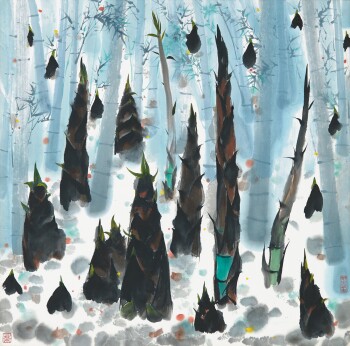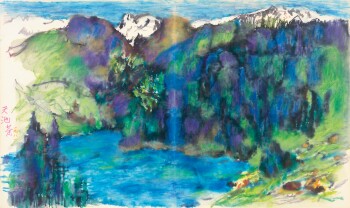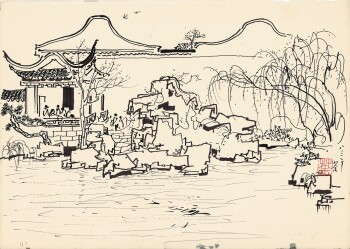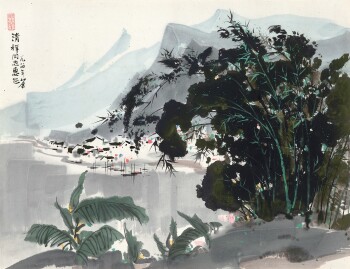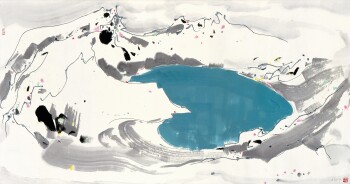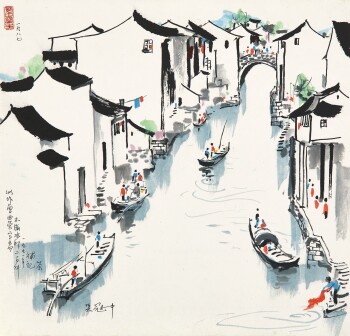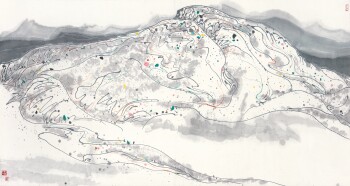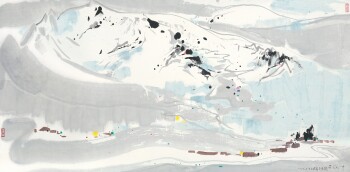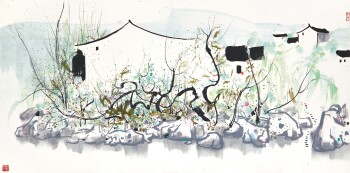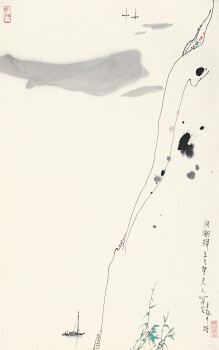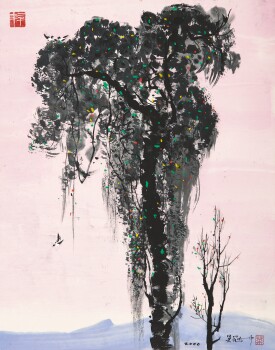W u Guanzhong's inspiration came not only from nature on a grand scale, but also the small delicate blooms and trees that flourish on mountains, in forests, and by the water. He especially cherished the part of nature that promised renewal. The artist would often help usher in the spring by venturing out in the wilderness in search of signs that the changing seasons will once again breathe new life into the world.
Not only is spring bamboo shoot delicious, its form is beautiful. Time after time I carried my box easel on my back to search for the spring bamboo forest ... Unfolded before me was a field of black bamboo sprouts, near and far, which appeared to be peeping at me, mocking me. They seemed short, shrunken with age. But I was wrong – they were sheaths left at the roots, which stayed to guard the young bamboo, now emerging a fresh, spring green color, as they stretched rapidly upwards into the sky.
Wu Guanzhong’s fondness for spring shoots stems from his childhood memory of harvesting them. He studied the robust growth of bamboo shoots, patiently waiting in the forest for an entire week just to capture the very moment the plant breaks through the soil. Executed in 1979, Bamboo Shoots in Spring celebrates that joy of seeing flourishing sprouts amid a dense forest. Painted in striking black, the shoots emerge hither and yon from the ground in a riot of stalks of all sizes – some stout, some slender – contrasting almost impudently with the tall and orderly bamboo in the pale blue grove. The artist refined the black sheath by adding subtle touches of reddish-brown, green, and turquoise, encapsulating the bursting vibrancy of his beloved evergreen plant.
"Autumn Thoughts" by Ma Zhi Yuan
Over old trees wreathed with rotten vines fly evening crows
Under a small bridge near a cottage a stream flows
On ancient road in the west wind a lean horse goes
Westward declines the sun
Far, far from home is the heartbroken one.
English Translations by Xu Yuanchong (1921- )
Wu Guanzhong professed an admiration for old trees, which he compares with the Yuan dynasty poet Ma Zhiyuan's similar affinity for gnarled trees and withered, tangled vines. The old tree embodies the resilience and persistance of the spirit, bent but unbroken by life’s vicissitudes. The artist revisited this idea countless times, often returning again to a figure that originates from a small oil painting he drew in Guizhou in the 1970s. These images may well be reflections of the artist himself.
"The tree, shadowed, looked wilting with its cloud of dense foliage rustling in the breeze and the drapery of tangling vines. It appears particularly lonely against the pale red sky, not even with the companion of magpies. This tree, desolate and abandoned, stands upright in the twilight – it is the heartbroken one far, far from home."
While Wu Guanzhong is known for his embrace of Western techniques in Chinese painting, it is noteworthy that classical poetry remained a source of inspiration, and his works remain deeply rooted in tradition. The composition of Ancient Trees exemplifies the way he alters the boundaries between poetry and painting.

The oil painting referenced above was the first interpretation of this idea, executed in 1972. Compared with the realism of that painting, Ancient Trees deploys a minimalist composition and a more dramatic use of color. Revisiting this theme in 2000, the artist intentionally left out the cottage and stone wall in the original composition and instead filled the background with watery shades of pink, emphasizing only the integral parts of the poetic imagery – namely, old trees, rotten vines, and sunset. Wu Guanzhong chose not to inscribe the poem on the work because “a large group of words would diminish the structural beauty of the composition.” The autumnal foliage and withered flowers in red, green, and yellow, serve as the sole decoration to the tree, amplifying the solitary sentiment expressed so poignantly in the poem. With the daring spirit of the artist, Ancient Trees attests to the well-known saying: “a picture is a soundless poem.”

In Bamboo Grove by the River, a bushy bamboo grove occupies a great part of the slope by the river and fills half of the canvas with its scattered stems and leaves. Through the bamboo and the banana trees on the left, viewers can get a tantalizing glimpse of the village on the coast just opposite. The delicate arrangement of different components, such as the white-walled houses and the vast mountains at the back, helps to create depth in this two-dimensional piece. The painting is most likely dedicated to Cheng Qingxiang, the general manager of the Beijing Hotel in the 1980s. The Beijing Hotel owned a gallery to provide Chinese artists with an official platform to hold exhibitions and to sell their artwork. Bamboo Grove by the River is based on one of his most repeated composition, originated from a sketch he painted during his visit to Guilin in 1972. While this work was painted in 1984 when the artist was trying to depict the bamboo grove he saw in Sichuan, the composition and color arrangement are very similar to another one of Wu’s work of 1976, New Bamboos Alongside the Li River.
The Artist's Relationship with Nature
As we have seen in the previous articles from the series on the artist, Wu Guanzhong's Reflections on the Heavenly Lakes – in the Artist's Own Words and Wu Guanzhong's Snowy Mountains – the Illusion in Painting Nature, each of his paintings reveals the changeable and subjective relationship between artist and nature. This is also true of his paintings depicting ancient river towns in Jiangnan in Southern China, a theme for which Wu Guanzhong was famous. As with his "illusions" of painting nature, his paintings of Jiangnan were full of personal emotion. Explore more of Wu Guanzhong's works at the upcoming Fine Chinese Paintings sale (10 July, Hong Kong).
- 1979
- 1981
- 1983
- 1984
- 1986
- 1987
- 1980s
- 1980s
- 1980s
- 1980s
- 2000
-
 1979
1979 -
 1981
1981 -
 1983
1983 -
 1984
1984 -
 1986
1986 -
 1987
1987 -
 1980s
1980s -
 1980s
1980s -
 1980s
1980s -
 Arnold Lee1980s
Arnold Lee1980s -
 2000
2000



